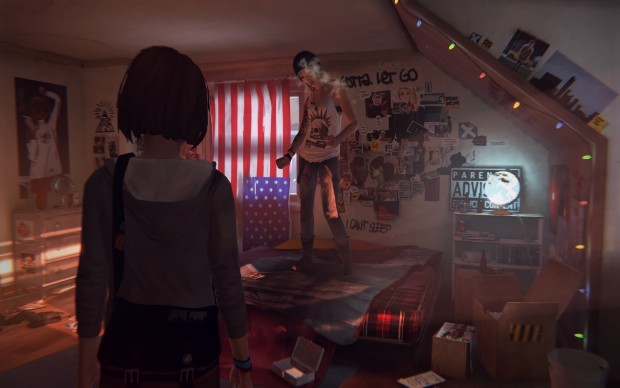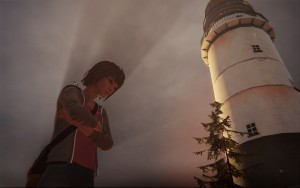Life Is Strange Episode 1 Review (PC)
- Updated: 2nd Feb, 2015

My favourite part of Life Is Strange’s first episode is the very ordinariness of Maxine “Max” Caulfield’s life. Here is a grad-schooler who’s just found out that she can rewind time. The world is her oyster and what does she use it for? Messing up her arch-enemy’s photo display and putting it back. Saving birds that fly into closed windows. Repeating people’s own phrases back to them so they think she’s cool to hang out with.
Dontnod Entertainment, the same developers who made Remember Me, have built a convincing world of young adults. There’s an unmistakable Gone Home vibe, not just in the teenage girl focus. You also spend most of the game learning about other people by digging through their stuff. You’re restricted to poking things that are marked but this focus and depth of response makes it far more satisfying than Gone Home’s long parade of empty shelves.
Music and photography are important to Max, and this is reflected not only in her room but in the art direction (and heavy bokeh) of the entire game. Scenes are often scored by the music from her headset or nearby radios, featuring music licenced from real-world indie bands.
Max isn’t affected by the time distortion, so she’ll remember everything she learned prior to rewinding. She’ll also retain her inventory, leading to awkward questions about the butterfly effect and how a photo of something that never existed can remain in your pocket. Best not to think too hard about that, though choice and consequences are the theme of the series.
 Every decision has an immediate, medium and/or long-term impact. I talked about Chloe and her stepfather in a preview back in February. No matter what you do in these obvious key scenes, Max will doubt her actions, underscoring both your agency and her lack of confidence.
Every decision has an immediate, medium and/or long-term impact. I talked about Chloe and her stepfather in a preview back in February. No matter what you do in these obvious key scenes, Max will doubt her actions, underscoring both your agency and her lack of confidence.
There are smaller things as well – I opened a cupboard and closed it. I saved a bird’s life. Both these things were noted as being consequential by on-screen HUD messages, whereas leaving the bird to die or rewinding the cupboard invasion would have gone unnoticed. I very much dislike this kind of flagging but based on The Walking Dead and The Wolf Among Us, people seem to want it. In this game, it felt more like a message screaming “YOU SHOULD REWIND THAT!” I’d rather hide those messages and find out later, at the end-of-episode list of choices.
A few of the puzzles require multi-stage solutions; solve a problem, discover a new one and then rewind to address both at once. The complexity keeps things interesting but also leads to some rather heavy-handed hinting. In one puzzle, the camera repeatedly panned over to a paint can that I needed to use next, while I tried to explore the rest of the area. I knew about the paint can – it had already been emphasised in a cutscene. I just needed some time to look around and figure things out.
 It’s understandable why they’ve done this – I was halfway through a section that needed to be rewound. Allowing me to leave the room and talk to people in the rest of the world would be a nightmare to rewind but at the time, it felt extremely awkward.
It’s understandable why they’ve done this – I was halfway through a section that needed to be rewound. Allowing me to leave the room and talk to people in the rest of the world would be a nightmare to rewind but at the time, it felt extremely awkward.
The strength of Life is Strange is the ordinary drama of a young woman’s life, with a dash of sci-fi and impending doom. The slow reveal of Max learning about her powers and your ability to use them so frivolously is a brilliant introduction to the series. Coupled with strong character writing and a beautiful style, this is shaping up to be a powerful, story-driven game.
Life is Strange Episode 1 is out now on PC, PS4 and Xbox One. Four more episodes will be released, with Episode 2 planned for launch in six weeks’ time.


Follow Us!